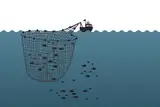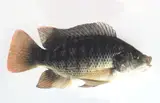Stay up-to-date on the latest developments from our world! Our news section is where you will find updates and insights.
Our mission needs your support
Your generosity can help ensure that our vital work on behalf of aquatic species continues uninterrupted. Please consider donating today so we may upkeep and expand our online database!
fair-fish international association
CHF: CH68 0900 0000 8503 8259 6
EUR: CH51 0900 0000 9136 2602 9
BIC: POFICHBEXXX
Bank: PostFinance, 3030 Bern, Switzerland
2025-05-24
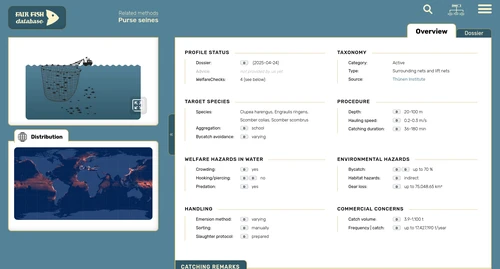
We launched a new part for the catch branch of the fair-fish database looking into welfare for wild-caught species caught with various catching methods. This new part is called a "method profile" (in parallel to a species profile) and takes the perspective of the capture method. For our first method profile, we chose "purse seines". For example, if a fisher owning a purse seine would like to know which welfare hazards to look out for, how to alleviate suffering for the species, and maybe even which species to target because it is least stressed by the method, this is the part to look at.
At the moment, the Dossier of the purse seines method profile comprises the information of the four WelfareChecks of small pelagic species caught with purse seines that we cover. With each new WelfareCheck involving purse seines, the method profile will grow. The structure follows the steps of the catching process, complemented with commercial relevance information, target species, and environmental impact.
The landing page of the purse seines method profile is an Overview similar in structure to the species profiles with pictures, a map showing where the method is applied globally, and general information about the capture method in the form of information snippets. For this new database part – but also for the database in general – we are looking for your feedback. Let us know what you think!
2025-05-09
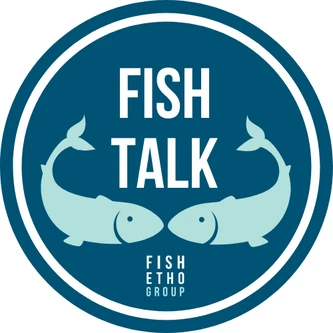
FishEthoGroup's latest podcast series of the fair-fish database programme of "FishTalk" covers our three tilapia species: Nile (Oreochromis niloticus), Blue (Oreochromis aureus), and hybrid tilapia (Oreochromis niloticus x O. aureus). For each of those, you will find some general information and a look into welfare hazards and how to improve those in just around 2 minutes listening time.
The information for these spotlights stems – as always – from the WelfareChecks of the species in our fair-fish database. You can find the podcasts in the respective species profiles as part of the Overview or over at FishEthoGroup. Enjoy!
2025-05-01
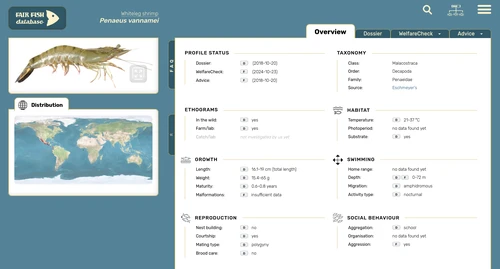
On April 24th, fair-fish conducted an Online shoal on the fair-fish database specifically. Some of the recent design and content changes that we presented there, we will cover in news post over the next couple of weeks. If you would like to re-watch the four presentations given during the shoal, please sign up for fair-fish's newsletter or write an e-mail to register. This time, we will have a closer look at the Overview that we overhauled. The Overview is the landing page if you have chosen a species.
We adjusted some of the criteria in the centre panel. For example, we added a status report on which other sub-pages are available (just WelfareCheck or Dossier and Advice, too) as well as a glimpse into the taxonomy. We added ethograms and broadened the handling and commercial relevance criteria to the catch branch. A species caught in fisheries will have these filled in. If you have questions on the meaning of these criteria, mouse over, and explanations will appear. What stayed intact: if you click on the reference button, you will be transported to where we got the information from.
In the left panel, we added more alternative Latin and common names of the species which will aid search for the species within the database. If you only know the (old) Latin or one of the common names: no problem! You can search by any of them. In general, we adjusted the colours to the corporate identity of fair-fish and chose a more fitting colour scheme for the distribution maps by Aquamaps (if available). We updated taxonomy and IUCN information. On the centre bottom, you will now find links to news posts that mention the species you have chosen. This way, you are always up to date with the most recent changes that we have covered in the news section. Your feedback and comments are welcome!
2025-04-16

The "Competence Centre Fisheries" coordinator will play a key role in advancing fair-fish's fisheries-related initiatives. This includes assessing fishery practices, developing welfare-based guidelines with partners, liaising with stakeholders, and contributing to research projects. The position requires a deep understanding of fishery science and animal welfare, if possible also practical skills and understanding of fisheries, as well as strong communication and project management skills.
If you are looking for a meaningful role in an internationally recognised organisation committed to fish welfare and are interested in an opportunity to contribute to innovative projects and shape better fishery practices, this might be the job for you! You will collaborate with experts in fisheries and animal welfare and have the potential for professional growth and participation in international events. We offer flexible working arrangements, a supportive team environment, and competitive payment. Please find all details here. Deadline to apply is end of April – we are looking forward to your application!
2025-03-28
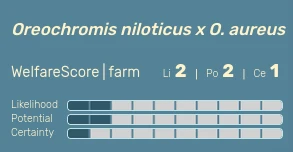
After Oreochromis niloticus (Nile tilapia) and Oreochromis aureus (Blue tilapia), we looked into their hybrid: O. niloticus x O. aureus. Although praised for better growth and higher cold tolerance compared to the parental species, welfare wise the hybrid is not more than the sum of its parts. Whereas O. niloticus reached a WelfareScore of 1|4|3 and belongs to the top 5 species we cover at the moment, the hybrid places at 2|2|1 and only reaches "High" scores for Potential and Certainty in about half the number of criteria than O. niloticus. This means that good welfare in the best case scenario may only be achieved in 2 of 10 criteria, and we are certain about our scoring (in terms of number and quality of sources) in 1 criterion.
Compared to O. aureus (1|2|0), it is a slight improvement of welfare which is good news as worldwide, ca 100 times more individuals are reared of this hybrid than of O. aureus. Still, in 9 out of 10 criteria we request further research to know better the situation as is and how to improve it. For details, please find the WelfareCheck here.
Lorem ipsum
In the fair-fish database, when you have chosen a species (either by searching in the search bar or in the species tree), the landing page is an Overview, introducing the most important information to know about the species that we have come across during our literatures search, including common names, images, distribution, habitat and growth characteristics, swimming aspects, reproduction, social behaviour but also handling details. To dive deeper, visit the Dossier where we collect all available ethological findings (and more) on the most important aspects during the life course, both biologically and concerning the habitat. In contrast to the Overview, we present the findings in more detail citing the scientific references.
Depending on whether the species is farmed or wild caught, you will be interested in different branches of the database.
Farm branch
Founded in 2013, the farm branch of the fair-fish database focuses on farmed aquatic species.
Catch branch
Founded in 2022, the catch branch of the fair-fish database focuses on wild-caught aquatic species.
The heart of the farm branch of the fair-fish database is the welfare assessment – or WelfareCheck | farm – resulting in the WelfareScore | farm for each species. The WelfareCheck | farm is a condensed assessment of the species' likelihood and potential for good welfare in aquaculture, based on welfare-related findings for 10 crucial criteria (home range, depth range, migration, reproduction, aggregation, aggression, substrate, stress, malformations, slaughter).
For those species with a Dossier, we conclude to-be-preferred farming conditions in the Advice | farm. They are not meant to be as detailed as a rearing manual but instead, challenge current farming standards and often take the form of what not to do.
In parallel to farm, the main element of the catch branch of the fair-fish database is the welfare assessment – or WelfareCheck | catch – with the WelfareScore | catch for each species caught with a specific catching method. The WelfareCheck | catch, too, is a condensed assessment of the species' likelihood and potential for good welfare – or better yet avoidance of decrease of good welfare – this time in fisheries. We base this on findings on welfare hazards in 10 steps along the catching process (prospection, setting, catching, emersion, release from gear, bycatch avoidance, sorting, discarding, storing, slaughter).
In contrast to the farm profiles, in the catch branch we assess the welfare separately for each method that the focus species is caught with. In the case of a species exclusively caught with one method, there will be one WelfareCheck, whereas in other species, there will be as many WelfareChecks as there are methods to catch the species with.
Summarising our findings of all WelfareChecks | catch for one species in Advice | catch, we conclude which catching method is the least welfare threatening for this species and which changes to the gear or the catching process will potentially result in improvements of welfare.
Try mousing over the element you are interested in - oftentimes you will find explanations this way. If not, there will be FAQ on many of the sub-pages with answers to questions that apply to the respective sub-page. If your question is not among those, contact us at ffdb@fair-fish.net.
It's right here! We decided to re-name it to fair-fish database for several reasons. The database has grown beyond dealing purely with ethology, more towards welfare in general – and so much more. Also, the partners fair-fish and FishEthoGroup decided to re-organise their partnership. While maintaining our friendship, we also desire for greater independence. So, the name "fair-fish database" establishes it as a fair-fish endeavour.
